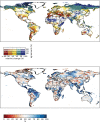Multimodel assessment of water scarcity under climate change
- PMID: 24344289
- PMCID: PMC3948304
- DOI: 10.1073/pnas.1222460110
Multimodel assessment of water scarcity under climate change
Abstract
Water scarcity severely impairs food security and economic prosperity in many countries today. Expected future population changes will, in many countries as well as globally, increase the pressure on available water resources. On the supply side, renewable water resources will be affected by projected changes in precipitation patterns, temperature, and other climate variables. Here we use a large ensemble of global hydrological models (GHMs) forced by five global climate models and the latest greenhouse-gas concentration scenarios (Representative Concentration Pathways) to synthesize the current knowledge about climate change impacts on water resources. We show that climate change is likely to exacerbate regional and global water scarcity considerably. In particular, the ensemble average projects that a global warming of 2 °C above present (approximately 2.7 °C above preindustrial) will confront an additional approximate 15% of the global population with a severe decrease in water resources and will increase the number of people living under absolute water scarcity (<500 m(3) per capita per year) by another 40% (according to some models, more than 100%) compared with the effect of population growth alone. For some indicators of moderate impacts, the steepest increase is seen between the present day and 2 °C, whereas indicators of very severe impacts increase unabated beyond 2 °C. At the same time, the study highlights large uncertainties associated with these estimates, with both global climate models and GHMs contributing to the spread. GHM uncertainty is particularly dominant in many regions affected by declining water resources, suggesting a high potential for improved water resource projections through hydrological model development.
Keywords: Inter-Sectoral Impact Model Intercomparison Project; climate impacts; hydrological modeling.
Conflict of interest statement
The authors declare no conflict of interest.
Figures



References
-
- Ohlsson L, Turton AR (1999) The turning of a screw: Social resource scarcity as a bottleneck in adaptation to water scarcity. Occasional Paper Series, School of Oriental and African Studies Water Study Group, University of London.
-
- Wallace J. Increasing agricultural water use efficiency to meet future food production. Agric Ecosyst Environ. 2000;82(1-3):105–119.
-
- Kummu M, Ward PJ, de Moel H, Varis O. Is physical water scarcity a new phenomenon? Global assessment of water shortage over the last two millennia. Environ Res Lett. 2010;5(3):034006.
-
- Oki T, et al. Global assessment of current water resources using total runoff integrating pathways. Hydrol Sci J. 2001;46(6):983–995.
-
- Rijsberman F. Water scarcity: Fact or fiction? Agric Water Manage. 2006;80:5–22.
Publication types
MeSH terms
LinkOut - more resources
Full Text Sources
Other Literature Sources
Medical

